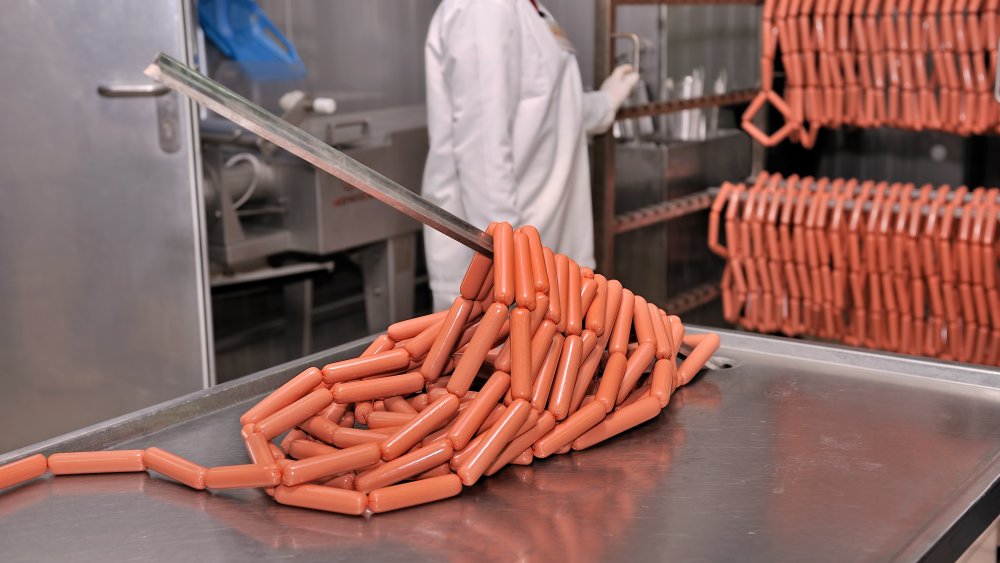Things You Don't Want To Know About Hot Dogs
Hot dogs are just about as American as baseball games and apple pie. Whether you prefer yours simple with a squeeze of mustard, or you'd rather load it up with chili, cheese, and onions, chances are you'll partake in at a few of them this year. At least that's the assumption, given the statistics shared by the National Hot Dog and Sausage Council (yes, that's a real thing). Their website states that in 2018 Americans spent more than $3 billion on hot dogs, and are expected to consume more than 7 billion of the popular wieners between the months of May and September — you know, "peak hot dog season."
But just because hot dogs are so popular (they're practically a staple at barbecues and baseball games), that doesn't mean they're the best thing you can put in your body. These cylinders of encased meat have a few dirty secrets lurking inside — especially if you're buying the cheapest versions on the market. Here are the things you don't really want to know about hot dogs, but that may help you make better buying decisions when you do throw a package in your shopping basket.
Your hot dogs might have foreign objects in them, like, er, glass
Look, everyone's heard the horror stories about finding foreign objects in food. Fast food joints tend to be big culprits, but the reality is, sometimes things go wrong in food processing, and items you don't really want to eat end up in your favorite fare. Unfortunately, hot dog manufacturers can't claim a completely clean record on this front. According to a 2015 article published in TIME magazine, 38 people had reported to the USDA's Food Safety and Inspection Service that they had found foreign objects in their hot dogs. Of course, 38 people is a small number given how many hot dogs are consumed each year, but remember, those are just the ones who took the time to make a report.
So what types of items have people found in their franks? The TIME magazine article reports the following (just to name a few):
- "A piece of rubber band"
- Tiny, hard white pieces of plastic
- "A clump of hair or something ratlike"
- "The tip of a razorblade"
- "Glass shards"
- Various pieces of metal (a wire, a staple, a button)
- "A piece of bone"
- "What looks like insect larva"
While the list is enough to make a person swear off hot dogs for life, the article also points out that hot dog recalls are relatively rare, so you can (mostly) trust that the hot dogs you buy won't come with an extra side of metal or plastic.
Hot dogs are ripe for foodborne contamination—yuck!
When you're starving and don't have a minute to spare, it's easy to think you can hit up the fridge, grab a hot dog, and eat it cold, right? Like other sandwich meats, hot dogs are already cooked, so it shouldn't cause a problem. And yet, according to John Muir Health, hot dogs (along with items like potato salad, chicken, and egg dishes) are "frequent offenders" for food poisoning. And if you've ever had food poisoning, you know you want to avoid another bout of this stomach issue at all costs.
According to an article published by the U.S. Food and Drug Administration (FDA), the issue comes down to hot dogs getting contaminated with Listeria monocytogenes after being processed and packaged. The FDA's clear advice — always reheat hot dogs until they're "steaming hot," and if you can't reheat a hot dog before eating it, you need to find something else to eat. It's just not a good idea to eat a cold, straight-from-the-package wiener.
Intestines in your hot dogs? No thanks.
So you probably understand that your hot dog (usually) comes stuffed inside a casing. This casing gives the hot dog its shape and also helps keep all the juices inside. If you've ever pricked a hot dog with a fork before putting it in a pot of boiling water or in the microwave, what you're doing is opening up the casing just a smidge to allow steam to exit the casing while the hot dog cooks. What you might not realize, though, is that whenever a label says "natural casing" or the ingredients include an item like "encased in sheep casing" or "encased in lamb casing," what that really means is that the hot dog is encased in animal intestines. Yum, right?
Here's the thing, though — it sounds gross, but it's not unsanitary or unhealthy (at least, not any more so than eating that hot dog in the first place). A writer for HuffPost conducted an interview with Boyd Adelman, the president of Sabrett, a hot dog manufacturer, in 2017. In this interview, Adelman explained that the intestines are completely cleaned before being used, so there's no risk of fecal contamination. And when you choose hot dogs with natural casings, you're helping reduce food waste and promote consuming the whole animal when animals are butchered for food. That said, if you can't stomach eating animal intestines, look for skinless hot dogs — these are prepared with cellulose casings that are removed before packaging.
There's probably not much meat in that hot dog
When you think hot dog, you think "meat," right? What else could a hot dog possibly be? And if you take the time to read ingredient labels, meat is typically listed as the first ingredient, followed by water, on hot dog labels. But that's not exactly true. According to a study titled "Applying Morphologic Techniques to Evaluate Hotdogs: What Is in the Hotdogs We Eat?" published in 2008 in the Annals of Diagnostic Pathology, scientists analyzed eight different brands of hot dogs to determine what, exactly, each hot dog consisted of. While "meat" (i.e., skeletal muscle — don't freak out, whenever you eat meat, you're pretty much always eating a combination of skeletal muscle and fat — that's literally what meat is) was listed as the first ingredient across the board, the actual skeletal muscle in each brand ranged from just 2.9 percent to 21.2 percent by volume, while water accounted for 44 percent to 69 percent of the weight of each hot dog.
So yeah, your hot dog is mostly water. And a little bit of meat. And what else, you might ask? Well, if you really want to know, it's a "variety of tissues," including bone, collagen, blood vessels, plant material, peripheral nerve, adipose tissue (fat), cartilage, and skin. Yikes. But if it helps at all, the study also noted that "brain tissue was not present." Thank goodness for small blessings?
Are there pig snouts in your hot dogs?
Okay, so beyond knowing the specific type of animal tissue you're consuming when you eat a hot dog, you might want to know what part of the body these tissues are being derived from, right? Well, hopefully, you understand that hot dogs aren't encasing prime cuts of beef or pork inside those cellulose or animal casings. It's not like you're paying an exorbitant amount for your package of dogs, even when you buy the high-end variety, so you have to know you're eating meat that's considered lower-grade.
According to a 2017 article published in Business Insider, hot dogs start with meat "trimmings." This vague descriptor basically means that the meat is taken from the "leftovers" of an animal after all the other, better cuts of meat are cut away. The article goes on to specify that these "trimmings" may come from lower-grade muscle, fatty tissues, head meat, animal feet, animal skin, blood, liver, and other "edible slaughter by-products." And that "head meat"? It's literally what it sounds like. Meat removed from the bones of an animal's head, which may include the cheeks.
Unless the hot dog ingredients include the label "byproducts" or "variety meats," it won't contain meat from the snout or lips. It also won't include eyes or brains... so that makes it better? Just remember, you typically get what you pay for — buying kosher dogs or 100-percent beef, chicken, or pork hot dogs is likely to be a better option if you're trying to steer clear of the less desirable "trimmings."
Hot dogs contain tons of fat and sodium
You probably haven't heard dietitians touting the health benefits of hot dogs as a way to reduce your risk of obesity, heart disease, or diabetes. That's because, obviously, hot dogs aren't a beacon of health. According to the Oscar Mayer website, the classic beef wiener contains 12 grams of fat (5 grams saturated), and 360 milligrams sodium. And that's just the hot dog. How often do you eat a single hot dog plain, without a bun or extra toppings? Probably rarely, if ever. If you're chowing down on two or three dogs in a sitting, along with a bun and an assortment of condiments, a single meal could rack up your fat and sodium intake pretty quick. Once in a blue moon, a meal like that won't do much damage, but if hot dogs are a staple in your weekly diet, it might be time to reassess.
Do keep in mind, though, that there are lots of different varieties of hot dogs on the market, including chicken dogs, turkey dogs, and lower-fat beef or pork dogs. You can even find tofu- or soy-based vegetarian versions. Each product will have its own nutritional information, and some might have lower levels of fat and sodium.
Hot-dog making is beyond horrifying
Maybe you've seen the videos. Maybe you've heard about them. Maybe you've been putting your head in the sand to ignore the rumors about how hot dogs are made so you can enjoy your frankfurter in blissful ignorance. Well, if you're ready to take off your blinders, here's the deal: Hot dog making is pretty gross. There's a five-minute How It's Made YouTube video you can watch if you're so inclined. Word to the wise: Don't watch it while eating... especially if you're eating hot dogs.
Depending on whether your hot dog contains "meat" or "mechanically separated meat," as defined by the USDA, in the list of ingredients, you may or may not be getting "extra calcium" (i.e. bone shavings) in your hot dog. If your favorite hot dog uses the word "meat" in its ingredients, it was likely separated from the animal using "meat recovery systems" or "advanced meat bone separation." This is similar in appearance to "hand separated meat." If your favorite hot dog uses the word "mechanically separated meat," you're consuming "batter-like or paste-like meat product produced by forcing bones, with attached edible meat, under high pressure through a sieve or similar device to separate the bone from the edible meat tissue." Sounds lovely, right?
Your hot dogs may contain white slime
So what exactly does the "mechanically separated meat" (MSM) used in many (but not all) hot dogs look like? The USDA might call it "batter-like or paste-like meat product" – neither of which sounds all that appetizing — but it still sounds better than "white slime," right? Well, when you buy hot dogs that include the phrases "mechanically separated meat" or "mechanically separated poultry" (MSP) in the ingredient list, you're consuming white slime.
White slime is what results when the bones of what's left of an animal and the remainder of the bones' attached tissue get forced under high pressure through a sieve, pumping out the edible portions while leaving the bones behind. The edible portions come out in a paste-like substance that amounts to meat sludge. It's this sludge, slime, paste, or batter (you choose your preferred descriptor) that then gets pumped into casings before being cooked and packaged into your favorite cookout treat.
If you can't handle this reality, read your ingredient labels. Higher-end hot dogs that include "meat" on the label (doesn't matter what kind of meat — beef, pork, chicken, or turkey), rather than MSM or MSP don't utilize white slime.
Hot dogs often contain nitrites and nitrates which are associated with cancer
Think for a second about what happens when you cook beef, pork, turkey, or chicken without any seasonings — you end up with a gray or white-ish meat, right? And considering hot dogs are pre-cooked using one or two of these various meats before being packaged, it just makes sense that hot dogs should look gray or white-ish. And yet, most hot dogs on the shelves of your local grocery store have a nice pink hue. So what gives?
A 2018 article published in Inverse points to sodium nitrite or sodium nitrate. These compounds are used in processed meats to help preserve meat and add flavor, but they also help give these meats their appetizing pink or red color. A fresh cut piece of steak is nice and red, right? But as it gets older it loses its red color. This has to do with the myoglobin in meat turning red when bound to oxygen. Over time, oxygen "falls away" and the meat loses its red tint. Sodium nitrite, on the other hand, can bind to myoglobin in place of oxygen and create this same "heme" that has a red hue. But unlike oxygen, it doesn't "fall away" as quickly, providing meat with a red tint for much longer.
The problem? As the article in Inverse points out, nitrites and nitrates have been linked to incidences of cancer. If you're concerned, look for hot dogs made without preservatives.
Someone once ate 72 hot dogs in 10 minutes
Most people would do well to eat fewer hot dogs overall. And by "fewer," let's say most people should limit consumption to a few hot dogs a month. As in, two or three. Total. But that's most people, not people involved in the weird, weird world of competitive eating.
In the world of competitive eating, particularly for the world-famous Nathan's Hot Dog Eating Contest which is held annually on the Fourth of July, competitive eaters have 10 minutes to stuff their faces with as many hot dogs and buns as they can. Sporting News reported that in 2018, a new world record was set by Joey Chestnut when he demolished 74 hot dogs. Think about that for a second — 74 hot dogs. If contestants are consuming Nathan's Skinless Beef Franks, Chestnut consumed 9,620 calories, 888 grams of fat (370 saturated), and 35,520 milligrams sodium in 10 minutes. That's downright obscene.
According to another article in Sporting News, in 2019, winners of the contest (Chestnut won in 2017 and 2019, too) earned a $10,000 purse — and if someone can consume 74 hot dogs in 10 minutes, the purse was well-earned.
That "kid-friendly" hot dog is a serious choking hazard (and not just for kids)
Kids love hot dogs. And parents love feeding kids hot dogs because: 1) they're inexpensive, 2) like chicken nuggets, they're practically guaranteed to be eaten without protest, 3) they're quick and easy to make, and 4) kids can choose their own toppings and customize to their heart's content. Unfortunately, the long, lean tube-shape of the humble hot dog is practically identical in shape and size to a human esophagus.
According to John Hopkins Medicine, choking on hot dogs is the leading cause of food-related choking in kids under 3 years old. So while your little one might want to eat a hot dog the way you do — encased in a bun straight off the grill — it's best to slice or mince their dogs into much, much smaller, less tube-like pieces. And it's not just the littlest kids that you need to think about — according to an article in The Washington Post, choking on food is the 19th leading cause of death in the United States, with about 17-percent of food-related choking deaths attributed to hot dogs. So, yeah, maybe everyone should start enjoying their hot dogs like Shake Shack's "flat top style," which are sliced in half before being grilled. Anything to help save a life, right?











